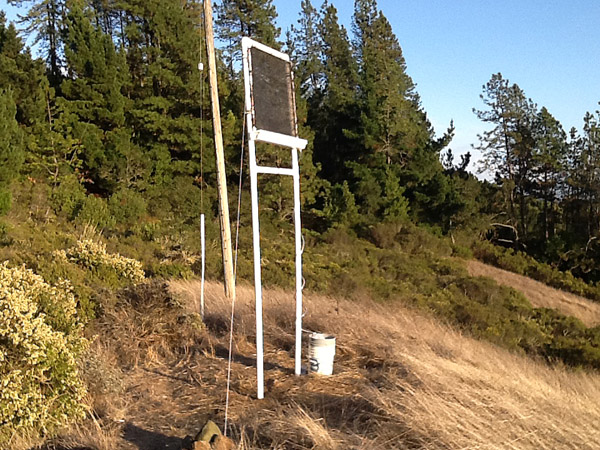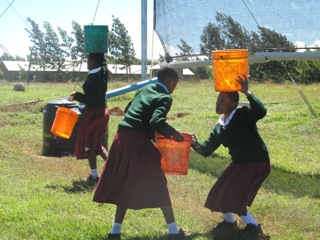This is a news story put together by CFJC TV in Kamloops (British Columbia, Canada) on our continuing fog collection projects in Nepal. It features brief interviews with Robert Schemenauer and Byron Bignell. The fog collection technology was introduced into Nepal about 15 years ago on visits by filmmaker Kevin Kowalchuk and the original FogQuest field project director, Pablo Osses, working in collaboration with Robert Schemenauer. FogQuest works with Canadian based groups NCDC and NCDF as well as the Nepalese NGO NEWAH.
Category Archives: Latest News
Latest News Update October 2014
 October 2014 – Fog Water for Coastal California : Evaluation at Tilden East Bay Regional Park, San Francisco
October 2014 – Fog Water for Coastal California : Evaluation at Tilden East Bay Regional Park, San Francisco
It is evident to those who live in California that there is fog along the coast at certain times of the year. The collection of fog by trees was noted in the late 1800s. The value of fog water for sustaining trees and other vegetation was studied in the 1900s and some measurements were made of fog collection rates. There continue to be some studies of fog collection fluxes along the coast in more recent years.
FogQuest is frequently contacted by individuals and institutions in California for our opinion on whether fog collection can be a viable water supply in select locations. Our response is cautiously positive but we emphasize that a proper evaluation using small Standard Fog Collectors (SFCs) must be done to define how much water can be collected and what the seasonality of the water collection is. Very few of these queries from individuals result in measurements that are done in a manner that might be useful in defining the resource. An exception is the initiation of a short-term study by Chris Fogliatti in recent months.
Chris built a modified SFC and some other mesh panels and installed them on Vollmer Peak in Tilden East Bay Regional Park at an elevation of 1820 feet (555 m). This is on the east side of San Francisco Bay above Berkeley. The setup is shown in the photo. At the site he chose, there was fog collection on about one day in three from late September to mid-October. The average collection rate was about 2 liters of water per square meter of mesh per day (a half a gallon per square yard) over the three week period. This is a low rate but would provide a useful source of clean water for vegetation and perhaps other uses. The results are encouraging and Chris plans to build new collectors that closely follow the design of the standard and also will relocate his collectors to potentially better sites. He has a background in environmental toxicology and is also interested in the chemistry of the fog water.
FogQuest is a small charity and Chris is operating on a low budget. If you would like to help support this work and move towards more measurements in the San Francisco area, please make a donation using the PayPal button on our website, or contact us at info@fogquest.org.
Latest News
March 2014 – Donations
As a charity, we are very dependant on donations from our private and corporate supporters. We would like to thank all those who contributed to the success of our projects by providing financial support in 2013. Many donations are made at year end and receipts for those went out at the end of February 2014. Those who have taken advantage of the CanadaHelps option for donations will have received their receipts directly online at the time of donation. We thank you in advance for your help in 2014. To all those who write to FogQuest for help with your projects, we encourage you to make a donation, no matter how small, to help us provide clean water to those in need.

February 2014 – Credit Card Service
We are a small not-for-profit organization operating on an all-volunteer basis. As such, we need to be ever mindful of both the financial and human costs in carrying out our projects. We keep our overhead very low by means such as paying no salaries and paying no rent for office space. In the past we have maintained an office capacity to process VISA, MasterCard and AMEX credit card payments. This has significant costs to both maintain the terminal and to pay a percentage of each transaction to the company providing the service. The demand for such capacity has gone down in recent years now that our website accepts PayPal payments plus credit cards for most items we sell and for some services. We are therefore going to stop our office credit card service shortly unless we hear from our members and visitors that there is a substantive reason to retain it.
January 2014 – Project in Tanzania

The fog collection projects in the central interior of Tanzania are progressing well under the direction of the German NGO ped-world, with whom FogQuest is cooperating. Presently there are fog collectors providing water for secondary and primary schools in Quameyu, Umagi, Endabok, Endoji and Gidng’ata. There are 4 to 6 large fog collectors (LFCs) in each location. FogQuest has just sent 10 rolls of the mesh we use in fog collectors, from Chile to Tanzania. This is enough for up to 50 LFCs. It is expected that 10 new LFCs will be built in 2014. The four photos here are courtesy of ped-world and show some of the collectors and water tanks at the schools.
Colombia – October 2012
Evaluation Project Update
Together with our NGO partner in Colombia, Fundación Occidente Colombiano (FUNCO), FogQuest continues to develop an operational project at site KM 18.
Positive water collection rates from non-standard SFCs are coupled with much enthusiasm. The students at the local school Francisco Jose Lloreda Mera (Francisco Miranda campus) focused on their experiences with fog collection as their final term projects. These student presentations have served to heighten local and regional knowledge about fog collection technology. Local NGOs, university and government stakeholders are hearing from the youth all about the untapped possibilities in their backyards. Catch a glimpse of this emerging project through the short video produced by FUNCO. ¡Disfrútalo! Enjoy!
New Evaluation Project in India – September 2011
New Evaluation Project in India – September 2011
FogQuest is assisting an Indian NGO called SOCIOserve to begin a fog collection evaluation in the mountains of Tamil Nadu where one SFC is now in Anavattan, which is a region just on the periphery of Poombarai.
Poombarai is a small village close to Kodaikanal. It is at an elevation of about 2200 m in the center of the southern part of the Indian sub-continent. Mesh has been sent to them for the construction of the SFCs and general guidance for the measurement program has been provided.
London Science Museum – September 2011
London Science Museum – September 2011
The Science Museum in London, England, has a new exhibit entitled Water Wars: fight the food crisis. It has some information on FogQuest and fog collection.
Latest News from FogQuest
We are now starting to produce a regular e-newsletter. Please sign up to receive our latest news regarding new & existing projects.
Your e mail address will not be given out to any other organization for any reason. Subscribe to our newsletter
New Evaluation Project on Mt. Kilimanjaro – August 2011
New Evaluation Project on Mt. Kilimanjaro – August 2011
 There are now Standard Fog Collectors installed on Mount Kilimanjaro in Tanzania. This was a joint effort with our partners in ped-world in Germany.
There are now Standard Fog Collectors installed on Mount Kilimanjaro in Tanzania. This was a joint effort with our partners in ped-world in Germany.
There is a tremendous need for fresh water for guides, rescue personnel and visitors on the upper part of the mountain. Up to now the water has to be carried 8 km to these high elevation huts. We are helping to determine whether the frequent fog found there can be a viable source of fresh water.
The altitude at Barafu is 4600 m and at Kibo-Hut 4750 m. Both are on Kibo-Saddle, the last camp before you reach the peak (5895m).



